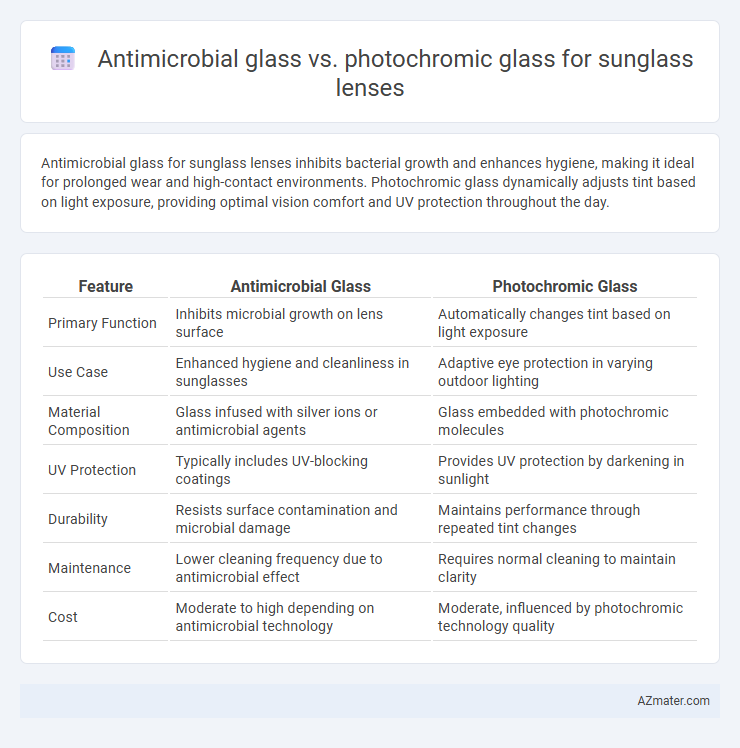Antimicrobial glass for sunglass lenses inhibits bacterial growth and enhances hygiene, making it ideal for prolonged wear and high-contact environments. Photochromic glass dynamically adjusts tint based on light exposure, providing optimal vision comfort and UV protection throughout the day.
Table of Comparison
| Feature | Antimicrobial Glass | Photochromic Glass |
|---|---|---|
| Primary Function | Inhibits microbial growth on lens surface | Automatically changes tint based on light exposure |
| Use Case | Enhanced hygiene and cleanliness in sunglasses | Adaptive eye protection in varying outdoor lighting |
| Material Composition | Glass infused with silver ions or antimicrobial agents | Glass embedded with photochromic molecules |
| UV Protection | Typically includes UV-blocking coatings | Provides UV protection by darkening in sunlight |
| Durability | Resists surface contamination and microbial damage | Maintains performance through repeated tint changes |
| Maintenance | Lower cleaning frequency due to antimicrobial effect | Requires normal cleaning to maintain clarity |
| Cost | Moderate to high depending on antimicrobial technology | Moderate, influenced by photochromic technology quality |
Introduction to Advanced Sunglass Lens Technologies
Antimicrobial glass and photochromic glass represent two advanced technologies revolutionizing sunglass lenses. Antimicrobial glass integrates silver ion or copper-based coatings that inhibit bacterial growth, enhancing hygiene and durability. Photochromic glass features molecules that react to UV light, automatically darkening or lightening lenses for optimal vision and protection in varying light conditions.
What is Antimicrobial Glass?
Antimicrobial glass for sunglass lenses incorporates specialized coatings or materials that inhibit the growth of bacteria, viruses, and fungi, enhancing hygiene and reducing the risk of infections. Unlike photochromic glass, which changes tint based on light exposure to protect eyes from UV rays, antimicrobial glass focuses primarily on maintaining lens cleanliness and user safety. This technology is especially beneficial in environments requiring high sanitation standards or for individuals with sensitive skin and eyes.
What is Photochromic Glass?
Photochromic glass is a type of lens material that darkens upon exposure to ultraviolet (UV) light, providing automatic adjustment to varying light conditions and enhancing visual comfort. Unlike antimicrobial glass, which incorporates coatings to inhibit bacterial growth and maintain lens hygiene, photochromic glass primarily focuses on light adaptability and UV protection. This dynamic response reduces the need for switching between regular glasses and sunglasses, making photochromic lenses a versatile option for eyewear.
Key Features of Antimicrobial Sunglass Lenses
Antimicrobial sunglass lenses incorporate coatings that inhibit bacterial growth, reducing the risk of eye infections and maintaining lens clarity over time. These lenses often feature durable, scratch-resistant surfaces combined with UV protection, enhancing both hygiene and eye safety in outdoor environments. Unlike photochromic lenses that primarily adapt to light conditions, antimicrobial lenses prioritize cleanliness and longevity, making them ideal for users seeking enhanced lens hygiene and reduced maintenance.
Key Features of Photochromic Sunglass Lenses
Photochromic sunglass lenses automatically adjust their tint based on UV light exposure, offering seamless transition from clear indoors to dark outdoors, enhancing visual comfort and eye protection. These lenses also provide 100% UV protection and reduce glare, making them ideal for varying light conditions without switching eyewear. While antimicrobial glass resists bacteria buildup, photochromic lenses focus on adaptive vision enhancement and convenience in sunglass applications.
Antimicrobial vs Photochromic Glass: Functionality Comparison
Antimicrobial glass for sunglass lenses inhibits the growth of bacteria and prevents microbial buildup, enhancing hygiene and durability. Photochromic glass dynamically adjusts its tint based on UV exposure, providing optimal vision clarity by darkening in sunlight and clearing indoors. Antimicrobial glass offers continuous protective cleanliness, while photochromic glass prioritizes adaptive light management for eye comfort.
Benefits of Antimicrobial Glass for Eyewear
Antimicrobial glass for sunglass lenses offers enhanced hygiene by inhibiting the growth of bacteria and fungi on the lens surface, reducing the risk of infections and maintaining clearer vision. This type of glass ensures long-lasting cleanliness and minimizes odors, making it highly beneficial for daily wear in environments prone to moisture and germs. Compared to photochromic glass, antimicrobial lenses provide a unique protective advantage, complementing UV protection with improved lens surface sanitation.
Advantages of Photochromic Glass for Sunglasses
Photochromic glass for sunglasses offers dynamic light adaptability, automatically darkening in bright sunlight and clearing indoors, enhancing visual comfort and reducing the need to switch between different eyewear. This technology protects eyes from harmful UV rays while maintaining optimal vision clarity in varying environments. Unlike antimicrobial glass, which primarily targets surface cleanliness, photochromic lenses provide superior functional benefits by adjusting to light conditions for continuous protection and convenience.
Choosing the Right Lens: Use Cases and Recommendations
Antimicrobial glass lenses provide enhanced protection by inhibiting bacterial growth, making them ideal for healthcare professionals and individuals in high-contact environments seeking hygiene and safety. Photochromic glass lenses adapt to changing light conditions by darkening in bright sunlight and clearing indoors, offering versatility and convenience for outdoor enthusiasts and everyday use. For those prioritizing cleanliness and antimicrobial defense, antimicrobial lenses are recommended, whereas photochromic lenses suit users needing adaptive vision protection across variable lighting.
Future Trends in Sunglass Lens Innovation
Antimicrobial glass is gaining traction in sunglass lens innovation due to its ability to inhibit bacterial growth, enhancing hygiene and user safety in everyday wear. Photochromic glass continues to evolve with improved transition speeds and adaptability to varied light conditions, offering enhanced visual comfort and UV protection. Future trends in sunglass lenses emphasize the integration of antimicrobial coatings with photochromic technology to create multifunctional lenses that address health and environmental responsiveness simultaneously.

Infographic: Antimicrobial glass vs Photochromic glass for Sunglass lens
 azmater.com
azmater.com